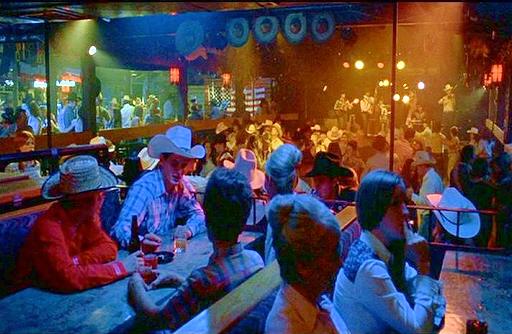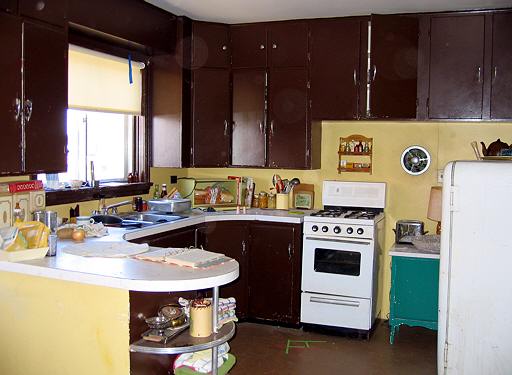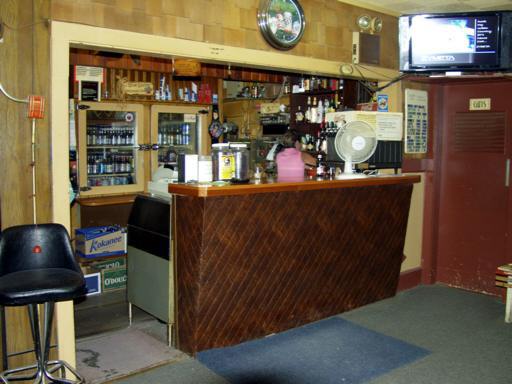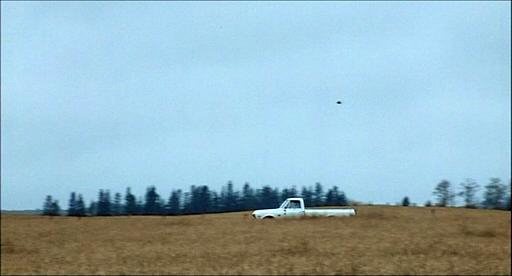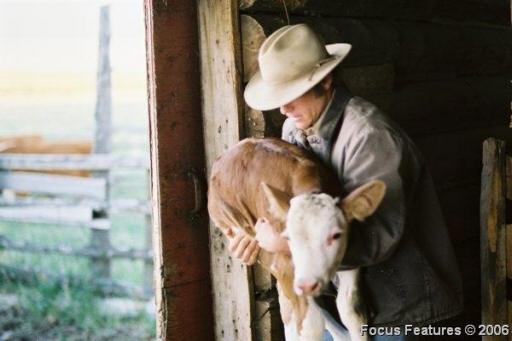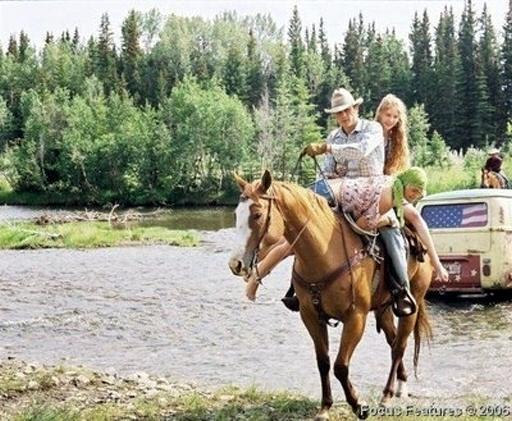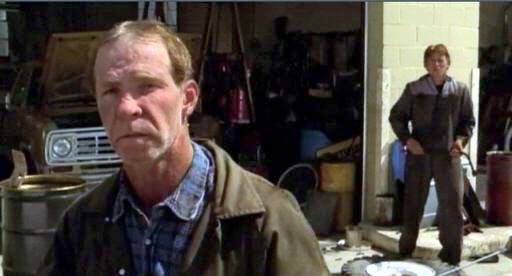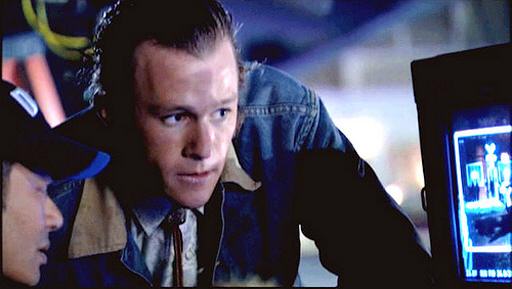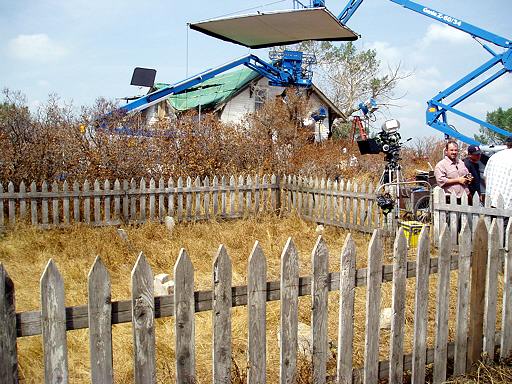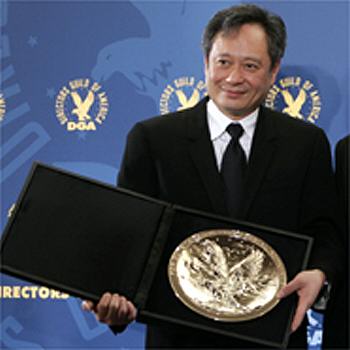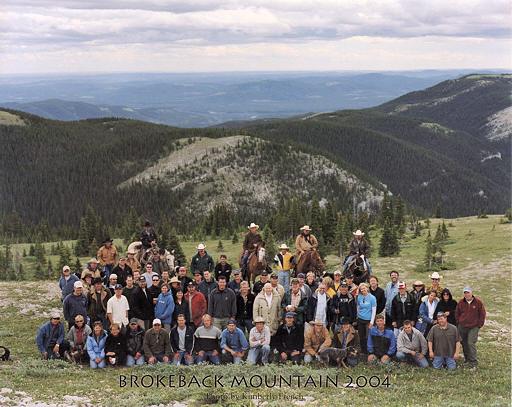The Childress Bar scene? Another big scene. That was fun; that day was just fun. Ranchman’s is an old cowboy bar down on Macleod Trail. It’s the real deal. They have pictures on the walls of a couple of generations of cowboys, Stampede saddles, championship rodeo saddles, hanging all around there. There is a whole series of those, and the place has a deep history. Most of the people we used [as extras] in that scene were regulars, they were just a lot of fun to work with. Those are some of my favorite things about this kind of work.
As a side note, Ranchman’s is also where we had our wrap party. It was the best wrap party I have ever been to. 25 The Laundry Apartment? You have to imagine the cast, cameras, lights, and a small army of people, in and out of there constantly, in the middle of summer. It was very warm and very cramped; after all, the space is quite small to begin with. It certainly gives you the feeling it was supposed to, and it was great for that.
This was the first time that Ang Lee had made a film outside of its “real” location. So he was adamant about finding locations that looked and felt “real.” And that was true of the Laundry Apartment. That confined feeling does come across in the film. The Rockyford Post Office? They did a lot of work there. When you are dealing with something like a post office, you need to be careful. There are subtle differences between a Canadian post office and an American post office that people will pick out immediately, so the art department had to be meticulous as to how they set that up. They basically started from scratch. I don’t think that building had ever been a post office before, so they had to do a lot of work there. It is funny, there are certain things you wouldn’t think would require a lot of effort [to make them “pass”] but one thing we came across was bars. American bars and Canadian bars are laid out entirely differently. An American bar has a long bar that goes down one side of the room. A Canadian bar is not set up that way. There are more tables and chairs with a much smaller square bar. So, for instance, when we were doing the [Electra bar] scene with Jack, we went through fits trying to find a bar with decent length to it, because Canadian bars are not set up that way. It may be a British influence, but it is a subtle difference between the places that caused us a lot of trouble. 26
Perhaps Americans are less social than Canadians? No, I think it is smarter business. You guys pack more people into less floor space. [Laughter.] Ennis’s Flashback? That was a tricky one. This was difficult because we had kids there, and we didn’t want the kids to have to see [Earl], so we split it up, using something else for them to look at that was not too scary. As for Earl, Ang did not want Brokeback Mountain to be a “speech” film. He did not want it to be a film about that. He wanted it to be about Ennis’s story. Ang didn’t want us to dwell on [Earl’s] image. We did not spend a lot of time in the Drumheller area, but we got some other great stuff around there, visually. 27 The White Truck? It could have been done anywhere. When you get into the rolling wheat fields, it could be anywhere. This is one of the shots that linger on the schedule from day to day.
Why wouldn’t you just shoot this at the same time that you filmed Ennis looking at the truck? You have to understand that we’re primarily responsible for getting the actors on camera, and sometimes we just run out of time. Those other little shots you need to have don’t always get done at the same time. I know it sounds ridiculous, but it happens a lot. The [deleted] Ennis the Vet scene? This is where they wanted to show Ennis being a real cowboy. We wanted it to be clear that Ennis and Jack were still men; they were still cowboys. It was important to show that they were competent. It was also important to show their separate lives, that they did not just spend their lives pining for each other. So, to highlight the differences between them, it became important to flesh out the characters, to show who they were. 28
On rare occasions we’ll shoot things which are not explicitly in the script. That scene was, I think I recall, on the “wish list” of things we tried to shoot when we could. I can’t tell you why that did not make it into the film. Ang knows! The [deleted] Hippie scene? The Hippie scene was James Shamus’ addition. He was trying to add something that would show that they were good cowboys. It was not part of the original story. It was kind of controversial—well, not controversial, kind of questionable—as to whether it would be in the film or not after the first time we tried to shoot it. This was also a challenge for the guys, Heath and Jake, because they had to do a bit of real cowboy work. And they are not cowboys. We held a pre-production “cowboy camp” where we sent them out to train with T.J. Bews, our chief wrangler. Heath had more horse experience than Jake. Heath was actually a very accomplished rider. Jake became a good rider eventually, as well. It sounds silly, but the Hippie scene was “cowboy technical.” And, as it happened, we fell behind schedule because of that scene and we had to make that up later. Tell us about some of the problems you encountered. Well, for all of our expertise, any film, especially a film like Brokeback Mountain, is essentially an artistic endeavor. So you’re trying to schedule things based upon your prior knowledge and experience, but, in the end, you can only make educated guesses as to how long scenes will take. If the weather is bad, if the horses won’t cooperate, if the river is too high, if the van won’t start, or a special effect does not work, well, there are so many things that can go wrong and throw your plans out the window. 29
This was one of those things that took longer than we thought it was going to. The weather was not great, the river was high, getting that VW bus in the river and getting it ‘stuck’ so that we still could pull it out, getting the horses in the water—there were lots of little things we had to arrange to make the scene work. And of course, whenever you put a vehicle in water there are strict environmental rules; you have to make sure there is no oil or gas in it. That can be a big pain in itself. It’s always the little things that cause you to fall behind. It happens on many productions; you fall behind and you have to make it up. It is a big part of your job as an assistant director to find ways to make it up without compromising anything. Unfortunately, this is one of those scenes we went to a lot of trouble to do, and it did not make it into the picture. But in the end it is the best thing for the picture. You can’t argue with that. The [deleted] Sneering Mechanics scene? We shot that very quickly, but it did not make it into the film, which I thought was an interesting choice. It leaves Jack’s demise open to question. You are not sure if you see Ennis’s fears or what actually happened. I guarantee you that Lee did that expressly, the superb filmmaker that he is, so that there would be questioning. If he had included this scene, you would have known immediately what happened, and why, but because he didn’t, you are not sure if Lureen is telling the real story. You’re left to wonder about the truth behind Jack’s death. 30
It was a way of making it less explicit, and leaving the story much more open to interpretation. I’m sure that was a big debate, a huge choice. It was a tiny thing, but a very important piece of the picture that he purposely left out. The Thanksgiving Fight Bar scene? This was one of the times when Mr. Hausman turned the set over to me and said, “This one is yours, go ahead.” This is one of the few times in the film when something really brutal happened, and Ang wanted it to be horrific. There are two examples of this in Brokeback Mountain: the Fireworks fight scene, which is shorter, and this scene, which is one of the best fight sequences I have ever worked on because it looks so real. We did quite a few takes to give Ang exactly what he wanted. This was difficult; we did not want it to look like a Hollywood fight. To achieve that, we had to do quite a few takes to bring it right up to the edge—not to go over the edge, but to go just far enough. What sometimes happens with performers is that they are so ingrained in how Hollywood makes movies that to achieve realism you must de-program them a bit. 31
Heath Ledger actually broke the nose of Ken Zilka, the stunt man, in one of the takes. Heath’s elbow hit Ken by accident, purely by accident. Zilka is a phenomenal stuntman, an absolute professional; it was part of the choreographed raw fight. It had such frenetic energy that when they were tussling, his elbow swung around and hit Ken in the nose. Although he broke it, nobody knew it. Ken didn’t tell anyone. In fact, we did four or five takes after that. The only reason I know is that Ken told me several weeks later that he had had his nose broken. Both of the fight sequences were meant to be brutal and hard. I think we achieved that; I hope we did. The Three Mountains and the Creek Jump? Peter Wunstorf and I shot this. We had a list of mountains Ang specifically wanted in the film and this was on it. This mountain is called “The Fist.” You come around a little more and it looks like a fist from that side. I would not trust the sky; it may have been replaced. I remember we did spend a couple of days drifting around in the rain trying desperately to find something beautiful to shoot. [Laughter.] Sometimes, weeks ahead of time, we would go out and shoot from Ang’s list. Of course, you can’t simply take a camera and go. You must organize it. You must have what we call “craft services” with you, the grip equipment, and so on. You have to organize these things. Then, hopefully, you’ll have the right weather. If everything comes together you get a great shot. 32 You had special responsibilities for the crowd scenes. Tell us about the Childress Dance Hall Interior scene. Initially, I want to give a huge amount of credit to my colleague, Travis McConnell, who, unfortunately, does not get credit high up enough on the list when the credits roll. Although his title is “trainee,” he is an accomplished assistant director and he does extraordinary work with extras. Mr. Hausman was kind enough, generous enough, to basically allow Travis and me run of the extras, and that became our domain. There were not a lot of crowd scenes in the show, but they each had to be meticulously worked, because Ang wanted everything to be absolutely picture perfect. So scenes like the Rodeos, or the Childress Dance Hall Interior, had to be choreographed. Something such as this requires a lot of preparation because, when we have dancers on the floor, they have to be choreographed, to a certain extent, with the music we are going to play, so that it all looks organic. We don’t want them to be crashing into each other while we are trying to shoot the actors. And there is the costuming. Because it is a period piece, the costumes all have to, again, be picture perfect. The haircuts, as well. Everybody did a fantastic job of making this scene very real. It is my personal favorite. Really, I love it, too. It is quite subtle and the story takes a dramatic turn there. And I think the performances were extraordinary. The [deleted] Twist Cemetery scene? That’s an Ang Lee question. It had to do with how he wanted to finish the scene, maybe he wanted him to walk away [from the Twists] and not have that final moment.
33 Brokeback Mountain received astounding critical acclaim. I was not surprised by the critical reaction. It was obvious to me from the first time that I read the script that we had the potential to make a truly great film. I didn’t expect it to do anything commercially. I thought it would be a reparatory sort of thing. It might do well in major population centers, and possibly in Europe. I saw it as sort of a long term film, an enduring, serious film, but not a broad one. I was certain that the critics, the good critics, would see Brokeback Mountain for what it was. But I did not anticipate that it would be reviewed so broadly. There are many films that are reviewed only by a few critics; the others don’t bother. In this case, I was surprised by the number of reviewers that gave it attention. And it happened immediately. I thought it would take longer for the film to receive attention. In fact, I expected that it would be one of those films that developed word-of-mouth recognition, rather than review-driven publicity.
The wave of awards? My feeling, and the feeling of many of my colleagues at the time, was that we were working on an important film. I think we knew from the beginning that it was significant and unique. We didn’t know if we would ever have such an opportunity again as filmmakers. You know, you want them to come around, but they are very rare. Very rare. And so to get the chance was a privilege. As to the awards, I had no clue. That was completely surprising. I thought maybe it would get festival awards if it turned out well. We were all thinking maybe the European festivals, but we never guessed that it would earn mainstream Oscar or Golden Globe nominations. It was denied Best Picture. I was not surprised that it didn’t get Best Picture. I was pleased, so deeply pleased, that Ang got Best Director, and just as sorry that the cast did not receive better recognition [in the Academy Awards] because Jake and Heath did an extraordinary job in very difficult roles. Those are two exceedingly difficult roles to play well. They were nominated, and they were certainly given critical acclaim elsewhere; it would have been nice. 34 Quite honestly, I am not a big fan of the Academy Awards because I don’t think that they consistently reflect the best in motion pictures. So I was not completely surprised that it did not get picked. I was hopeful because of all of that momentum, but that’s the way it goes. The Academy Awards are a lot about publicity; it is often a publicity contest to see who puts on the best campaign. I don’t think that you can say that Brokeback Mountain was in any way inferior to any other film released, not just during that year, but in any subsequent year. It would count as one of the best films in the history of American cinema. At its heart it is a romantic tragedy, but it explores a situation that has never been addressed before. So whether it won Best Picture, or not, does not really matter. In the end, it is—will always be—an important and unique film, a story superbly told. You are a young man, but it must have occurred to you that this may well be the film that defines your career. We spoke of that as we worked on this film. Karen Bedard and I actually talked about this. Kind of half joking, but half crying, too, we considered that this may be the highlight of our careers, and we will look back upon it for the rest of our lives. This may be the peak. And if that proves to be the case, I accept that, because Brokeback Mountain will be very difficult to top. Not just because of the material, although it is a rare thing when you have the opportunity to work on a film that is so important, of such quality, a great story, and with a team of gifted professionals.
35 That last piece, the people, is the hardest part of all; you can have great material but it only takes a couple of people to make things miserable for everybody else. That didn’t happen here. We had such outstanding leadership from Ang Lee, Michael Hausman, and Diana Ossana; they are such fantastic people to work with. And the cast—superb actors, all of them. You know, you have several hundred people working on a project like this. To have them all be so great at who they are and what they do, it was incredibly fortunate that we all came together for this film. The stars [in the heavens] aligned themselves. It’s going to be tough for that to ever happen again. Even if we come close, I’ll be overjoyed to even get near that again. People who are older than me will say the same thing, that they never had such joy as they did working on that film. Thank you. We are overjoyed by your generous gift. It has been my pleasure. You are doing important work. 36 |
